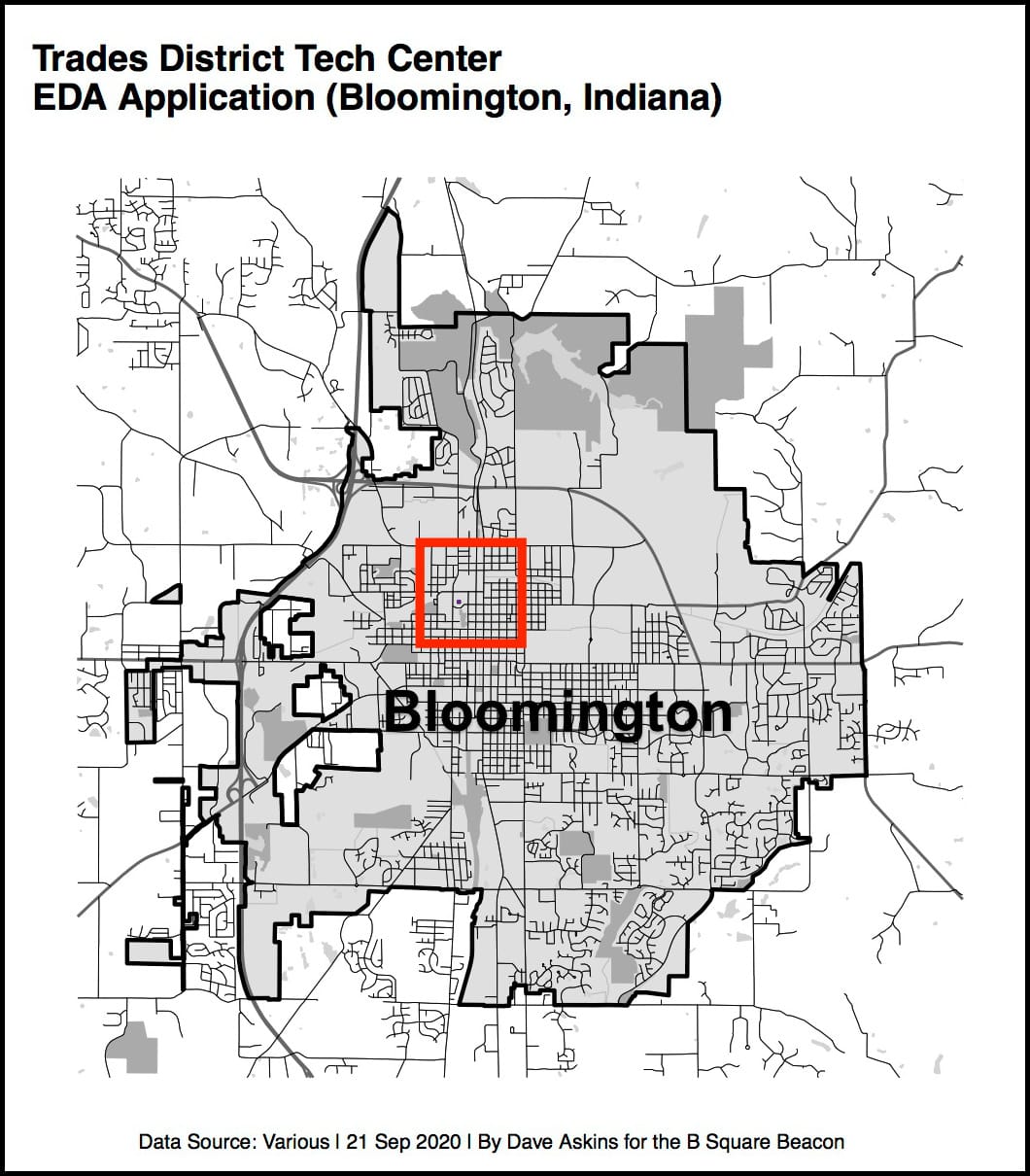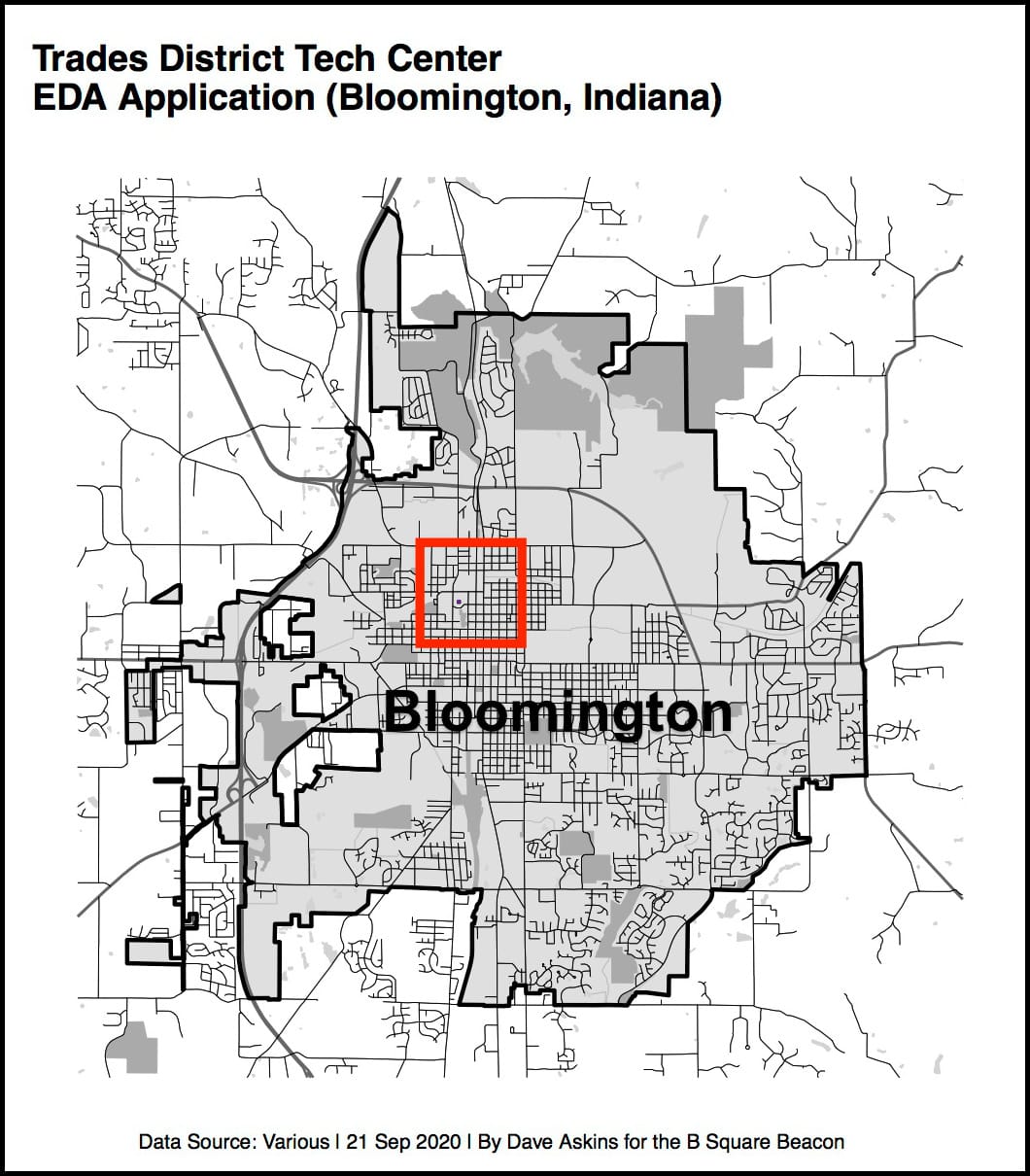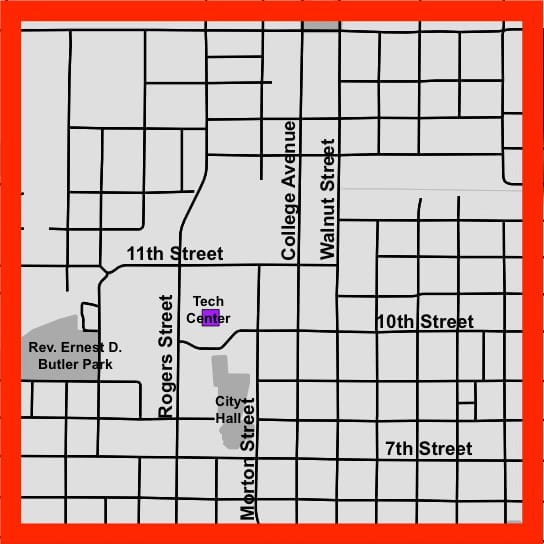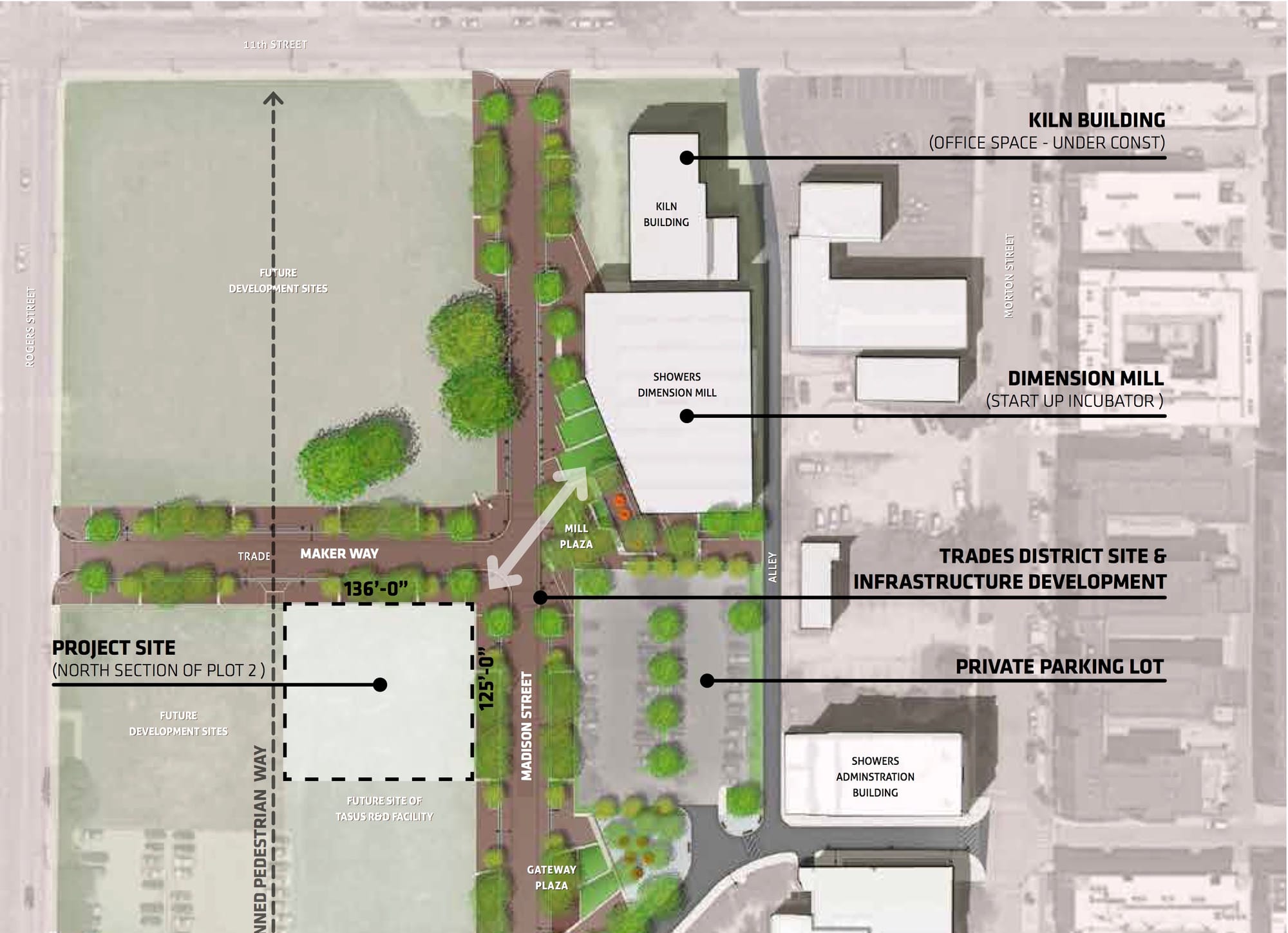Technology center application to feds for $9.4 million building gets more OKs from RDC, city council committee endorsement comes after grumbling





On Monday night, Bloomington city council’s four-member sustainable development committee convened a meeting to consider signing a letter of support for an application by the city to the federal Economic Development Administration (EDA). The city looking to build a technology center in the Trades District, just north of city hall.
A couple of committee members balked at being asked to vote on the question, because they’d received the supporting written materials just three hours earlier. So the letter of support from the committee had to wait for approval until Tuesday afternoon when the committee resumed its recessed meeting from Monday, missing one of its members.
The Tuesday afternoon meeting lasted just six minutes, which included a reading of the letter aloud into the record. One missing instance of the word “of” was noted and corrected before the letter was approved.
The application had received an initial OK in early August from the city’s redevelopment commission (RDC). The RDC is involved because it owns the land, and the project requires expenditure of about $2 million in tax increment finance (TIF) funds, money that the RDC oversees.
A couple hours before the city council’s committee met on Monday, the RDC amplified the application’s green light, given six weeks ago, with some additional endorsements. The five voting RDC members unanimously endorsed a feasibility study, a Comprehensive Economic Development Strategy (CEDS, pronounced /sεdz/), the funding match, and use of the land.
The RDC owns the real estate and would continue to own it, along with the building, after it is constructed. According to representatives of Axis Architecture + Interiors the construction could be completed, possibly by the end of 2022.
If the EDA were to approve the application, the $2 million in local funds would get a 20-80 federal match to pay for the construction of roughly $9.4-million, 3-story, 31,375 square foot building at Maker Way and Madison Street, north of city hall in downtown Bloomington. The estimated dollar figure includes architectural and engineering design fees, permits, inspections and connection fees.
The federal funds would be available through the Coronavirus Aid, Relief, and Economic Security (CARES) Act.
The city of Bloomington is the lead applicant for the project. A key partner on the project is the Bloomington Economic Development Corporation.
On Monday, the city’s economic and sustainable development director Alex Crowley and BEDC president Jennifer Pearl presented the project to the city council’s sustainable development committee. They described a tight, self-imposed deadline of Wednesday for submission of the city’s application.
Pearl said they’d heard from the EDA that a “wave of applications” for the limited amount of funding was starting to roll in. So Crowley and Pearl appeared keen to avoid the pass rush and at least to heave the ball into the air toward the end zone. Crowley called it “a bit of a Hail Mary.”
Committee chair Sue Sgambelluri wrapped up the committee meeting by thanking the representatives from the city and the BEDC: “I will offer the comment that—dynamics of this committee aside—please know how much I appreciate Mr. Crowley and Ms. Pearl and your work on this. And the work of the team.”
Sgambelluri’s allusion to the committee’s “dynamics” was a diplomatic way of describing the discontent that Steve Volan conveyed to Crowley and Pearl, during the last half hour of the committee meeting. He felt that committee members should have been provided written materials earlier than three hours before the meeting.
At one point, Volan gave an ultimatum. He said he’d vote no on a letter of support unless the committee waited to vote until Wednesday. Volan did not attend the committee’s Tuesday afternoon continuation of its Monday meeting.
Why a Technology Center?
President of the BEDC, Jennifer Pearl, described how a study by Battelle Technology Partnership Practice had identified technology as a key cluster for economic opportunity in southern Indiana. Tech is still growing, Pearl said, and tech applies across almost all other sectors of the economy and can strengthen existing industries in the region, like life sciences.
Technology also ties to two key public resources of technology development, Pearl said. Those are Indiana University and Crane Naval Surface Warfare Center. It’s less expensive for tech companies to locate in Bloomington compared to the east or the west coasts, she said.
Pearl also pointed to a certain momentum in the area economy for a focus on technology. The technology center would be situated in a certified technology park, which was established in 2005. In 2013, a Trades District master plan was developed, which recognized the area as a growing center of technology. In 2017, the city and the BEDC launched The Mill, which is a co-working space.
The tech center building, according to the supporting materials from Axis Architecture + Interiors, would be designed to support the goals of “evolving, supporting, connecting, and inspiring technology-focused companies.” The building would include a mix of small- to medium-sized tenant spaces, a central atrium/lobby space and outdoor roof terraces.
The building would be operated by a non-profit entity, which would coordinate programming and services for local tech companies. The building would also provide space for existing tech companies to co-locate and “create synergy with one another,” Pearl said.
The target tenants for the building are technology companies that are beyond the startup phase, Pearl said. Services and space would be available for growing and mature firms. The kinds of services that would be provided would include: connections to local and regional tech companies. The feasibility study that was conducted for the project showed that a technology center providing connections between companies was not just feasible but needed, Pearl said.
Also a part of the mix of services will be support for “talent attraction,” Pearl said. Often, tech talent doesn’t realize there are opportunities for them beyond the university or larger institutions, she said.
Another kind of support provided by the tech center would be advisory services. Often, companies are great at their individual technologies, Pearl said, but they may need some support when it comes to knowing how to run human resources or do marketing.
Connections to additional sources of funding would also be a part of the services provided, Pearl said, whether it’s angel investors, or grant opportunities, Pearl said. A final kind of service would be connections to federal procurement opportunities.
Crowley described how the building is supposed to be self-sufficient within a few years. But he added, “The city would would come to council as part of the regular appropriations process, should there be operating support for the building.”
Councilmember Matt Flaherty wanted to know a ballpark figure for the kind of operating support might be needed if revenues from tenants did not cover operating expenses: “What type of money are we talking about, just ballpark?”
Crowley said the model had built in an average of about $150,000 a year in “gap spending” for the first three years. “If things go terribly wrong, it could be upwards of twice that amount,” Crowley said.
Committee dynamics
On Monday, councilmember Susan Sandberg was prepared to vote to allow Sgambelluri, the committee chair, to draft a letter of support and sign it as an endorsement of the committee. Sandberg said, “I cannot pretend that I’ve read the materials chapter and verse. But I have skimmed them prior to this meeting. The presentation on its own merit has been convincing to me that this is a little enough thing that we can do with respect to just endorsing. The money is there.”
Sandberg added, “The RDC has apparently unanimously voted in favor of supporting it. So it’s not like we’re speculating on: Do we have the funding to be able to do this?”
Less enthusiastic about voting was Volan, who had kicked off commentary after the presentation by saying, “I have no doubt that this project would benefit the community, but I, generally speaking, only vote on things that are in writing. A signature is a form of a vote.”
Volan added, “I am sure this is something that I’m likely to support, but I’m not going to do it tonight.”
Volan sketched out a timeline for his willingness to vote to endorse the application: “If there’s a second follow-up meeting, perhaps within a week, that is, time to read the materials, where there’s a letter that I can see and read before I agree to sign it, then I’m inclined to do so, but I’m not going to do it on three hours notice.”
Volan’s initial position was that if a vote were taken that night, he would not participate in it, even though he thought he would eventually support it: “I find the presentation to be mostly compelling. I probably I see myself supporting it, but not under these circumstances Not tonight. So if there is any kind of a vote tonight I’ll be abstaining.”
Councilmember Matt Flaherty echoed Volan’s concerns, but did not think a week of extra time was needed. Flaherty tried to find a kind of middle ground between the positions expressed by Sandberg and Volan. Flaherty said, “I probably lean a little bit on the side of what councilmember Volan said.”
But Flaherty was willing to work on a tighter timeframe than Volan: “I don’t feel like I need to wait a week, because I understand you don’t have a week, and that you’re wanting to submit this tomorrow or the next day, perhaps the latest.”
Like Volan, Flaherty wanted to see the text of the letter of support before voting on it. If a vote were held that night, Flaherty said, he would, like Volan, abstain.
After some additional back and forth, Volan made a second offer, this time for a shorter timeframe than the week he’d mentioned at first. He cited the 48-hour noticing requirement for a committee meeting that is prescribed by Indiana’s Open Door Law (ODL). “If we were to reconvene Wednesday at four [o’clock], I would feel comfortable voting, but no earlier than that time.”
Shortly after that, city council attorney Stephen Lucas weighed in to point out that the hour was approaching 8 p.m., which meant that a 48-hour noticing requirement would entail waiting until 8 p.m. on Wednesday.
Volan countered by pointing out that the committee could just recess the meeting and continue it at a later time, without being subject to the ODL’s 48-hour noticing requirement for a new meeting. Volan called his suggestion to reconvene at 4 p.m. on Wednesday “a reasonable offer.”
The idea that Wednesday was a self-imposed deadline and that a vote could not wait until Wednesday “very much bothers me,” Volan said. He added, “I shouldn’t have to beg for this kind of time.”
Volan’s observation about a continued meeting not requiring a 48-hour notice under the ODL gave Sandberg an opening to suggest that the committee resume its meeting as soon as the next day: “Could we meet sometime tomorrow, after the two council members [Flaherty and Volan] have had an opportunity to review their information?”
Volan’s immediate response: “I’ve stated the terms under which I’m willing to put my signature on a letter. So nothing before Wednesday 4 p.m.”
Flaherty’s position was softer than Volan’s: “I can be ready to vote on something by tomorrow afternoon, tomorrow evening, if we wanted to consider that, especially if we had a draft letter in hand.”
Kaisa Goodman, who is special projects manager for the city’s economic and sustainability department and is managing the EDA application, weighed in to say that the assembly of the application packet would require a letter to be ready for inclusion on Tuesday, saying, “We really would need it by the end of the day tomorrow [Tuesday].”
Volan asked, “I’m sorry, point of order, Madam Chair, is the thing due Wednesday, or is it not due Wednesday? I’m getting conflicting messaging here from the administration.”
Crowley confirmed that the city was looking to get the application out the door on Wednesday. And the mechanics of packaging up the application would mean having the letter of support by Tuesday.
Sgambelluri then made a gambit to recess but resume the committee meeting on Tuesday: “Let me suggest then, that based on what I’m hearing, there are varying degrees of comfort with signing off on something tonight, or voting in support of this project. May I suggest that we continue this meeting until tomorrow afternoon?”
Volan’s response did not embrace the idea: “This discussion has changed my vote to a no. I am not going to be taken for granted. I don’t appreciate that there was a possibility of 48-hours notice for these materials to be given, it’s not a lot to ask 48 hours notice that could have been submitted on Friday.”
Volan added, “I am accustomed to this from economic development—that it’s always a rush. It’s always: We always have to do it now. And I’m asking for two business days. I’m asking for the standard amount of time to consider fully the materials that you’ve given us, in order to put my name on something to vote on something. Because we are talking about this as a vote.”
Flaherty reiterated that he was not comfortable voting that night. His main point was that he wanted to see something in writing to know exactly what he was voting on.
Flaherty said he did not take Volan’s points lightly, but said, “I think if we all take it to heart, you know, I appreciate the administration’s efforts. This is a…very short timeline that they’re working with. So, trying to be accommodating, I would be willing and happy to to vote on a letter of support that we see in writing by tomorrow afternoon.”
Sgambelluri asked for scheduling availability of committee members for Tuesday afternoon. Volan said he had meetings all afternoon.
Some brief back and forth led Volan to move to recess and continue the meeting at 4 p.m. on Tuesday.
Before that motion got a vote, Flaherty told Crowley and Pearl that in the future, it would be better to go ahead and provide a council committee with materials sooner than they had for Monday’s meeting—even if they were still somewhat in draft form. Committee members would understand that the materials might not be in final form, he said. Flaherty thought if that approach had been taken in this instance, by providing a draft of materials on Friday, the committee would have been ready to vote on Monday.
Volan added to Flaherty’s remarks: “I mean, you’re letting the perfect be the enemy of the good. Send us what you have. But do it with sufficient notice. …It doesn’t need to be perfect. But we need to know what it is we’re being asked to do. Again, I’ve had three hours notice. You know, there’s a reason we have a 48-hour public notice law.”
The vote on the motion to recess and resume the meeting at 4 p.m. on Tuesday was 3–1 with dissent from Volan, because he could not attend.
With the scheduling issue dispatched, Monday’s session appeared ready to conclude. Crowley and Pearl sketched out how they were available to committee members to answer questions between then and the following day. Crowley told Volan that the planned building is in Volan’s council district, so he wanted to make sure Volan understood what was going on with it.
Pearl told committee members they should feel to use her cell phone number to contact her if they had any questions.
Pearl also mentioned that the city and the BEDC had originally set for themselves a deadline at the end of September for submitting the application. They’d tightened the timeline, Pearl said, because “We heard from EDA that they were getting a wave of applications coming in. And they said as soon as you can get it in, the better. Just because when the funds are gone, they’re gone.”
That prompted Volan to quiz Pearl about the communication from the EDA. “One question, Ms. Pearl. When did that phone call happen?” Pearl said she’d have to check her records.
Volan followed up: “Was it last week? Was it two weeks ago? How long ago, roughly?”
Pearl indicated it was about three weeks ago.
Volan said, “OK, so you knew three weeks ago? And I mean, I’m sorry, that doesn’t wash.” He added, “If you knew three weeks ago, you could still have sent us some material a couple days ago… That just unfortunately, that makes me even more disappointed…”
Goodman said some of the documents had not been received from different partners on the project until that same day, Monday. Volan wanted to know which documents hadn’t been received.
Volan said, “So I got four attachments today… which of these documents was not ready?”
At that point, Crowley waded back in, saying that, in fact, all the documents are still in progress.
Crowley told Volan, “I mean, look, I think your point is well taken, which is, you know, sometimes…we want to try to get things as tight as possible before we effectively go public with them. And, you know, and there are various stages of completion. And these things have been, I mean, literally, we’re all burning the midnight oil here.”
Crowley continued, “While I understand your concern, we were not sitting around twiddling our thumbs until the last minute and then firing them off. I know, that’s not your implication, but you should know, a significant amount of effort has gone into this.” He added, “I have to say, you know, we were not sitting on these documents.”
Volan respond by saying, “I have not in any way implied or meant to imply that someone was twiddling their thumbs or delaying to the last minute. I’m very glad to hear you say to recognize that you know, you could have released something that was less polished.”
Volan finished his remarks to Crowley by saying, “Don’t let the perfect be the enemy of the good, anymore. I appreciate it. Thank you for saying that.”
In closing Sandberg expressed her appreciation for the work of city staff and the BEDC: “I want to thank Ms. Pearl and Mr. Crowley and Ms. Goodman. I completely understand the position that you’re in.”
Sandberg included an indication of discomfort with Volan’s remarks towards the three. She told them she was “a little bit uncomfortable with this wrist-slapping of you at this point in time.”
Sandberg looked to Sgambelluri to end the awkwardness: “Madam Chair, can we adjourn this meeting? We have our next steps already organized and ready to go. I would like to get on with my evening. Thank you.”
Volan’s riposte: “I finished my comment, point of order, Madam Chair. I don’t appreciate the comments from my colleague.”
It was at that point when Sgambelluri offered her conciliatory closing: “I will offer the comment that—dynamics of this committee aside—please know how much I appreciate Mr. Crowley and Ms. Pearl and your work on this. And the work of the team.”




Comments ()